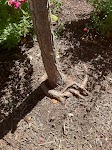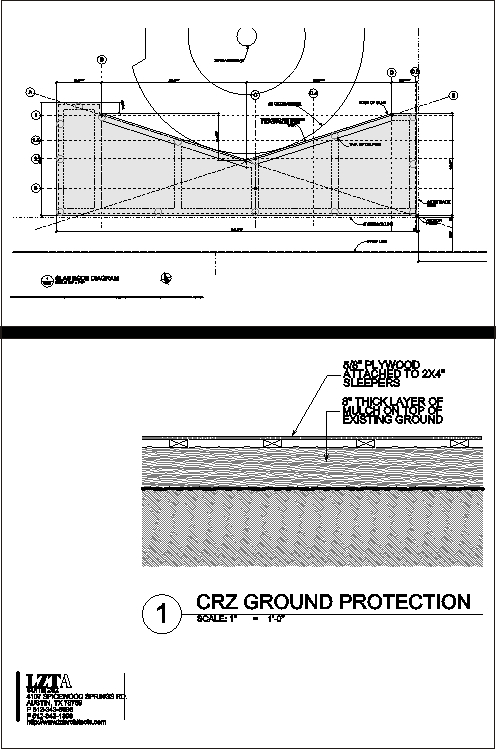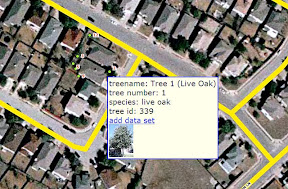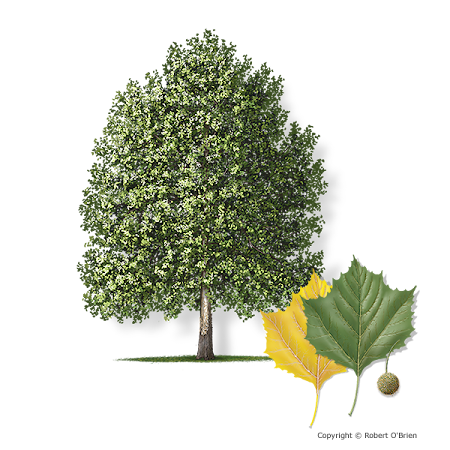 Most planted trees in the Austin area are container grown trees. Most container grown trees develop girdling roots. If you’ve planted a tree, there is a good chance this is going to be an issue for your tree. Girdling roots are a serious problem. The end result is the tree literally choking itself. Tree death is the typical result from severely girdling roots. Even if your tree is lucky enough to survive, overall health and vigor will be poor. Behind construction and weed-n-feed damage, this is probably the third most prevalent and serious tree issue I run into out in the field (especially for transplanted trees). The picture to the left shows a typical looking girdling root. Keep in mind these aren’t always visible from surface level. Sometimes you have to dig down to find them.
Most planted trees in the Austin area are container grown trees. Most container grown trees develop girdling roots. If you’ve planted a tree, there is a good chance this is going to be an issue for your tree. Girdling roots are a serious problem. The end result is the tree literally choking itself. Tree death is the typical result from severely girdling roots. Even if your tree is lucky enough to survive, overall health and vigor will be poor. Behind construction and weed-n-feed damage, this is probably the third most prevalent and serious tree issue I run into out in the field (especially for transplanted trees). The picture to the left shows a typical looking girdling root. Keep in mind these aren’t always visible from surface level. Sometimes you have to dig down to find them.
Continue reading Girdling Roots
Tag: tree
Tree Removal Permit in Austin
Be careful before you remove a tree in your yard if you live in Austin. Many of the trees in Austin are protected. Possibly even some in your yard! The city’s tree protection ordinance is somewhat complicated. Here is some info to get you started.
- In residential settings, trees 19″ DBH (diameter at breast height, approx 4.5′) and larger are protected
- In commercial settings, trees 8″ DBH and larger are protected
- Trees 24″ and larger are classified with heritage status
- Removing or pruning out more than 25% of the canopy of a protected tree requires a permit
Working Within the CRZ of a Heritage Tree
The city of Austin is very demanding that you do not impact what is defined as 1/2 of any heritage tree’s critical root zone (CRZ) during construction and development processes. And, rightly so. If you are building around a tree and expect it to live, rooting area needs to be preserved. Unfortunately, sometimes the city’s CRZ protection requirements can really restrict design ideas and site use. During one particular project I worked on with David Carroll with LZT Architects, the design successfully avoided breeching the 1/2 CRZ of a heritage tree, however, the contractors needed a few feet of access around the edge of the new building. The problem was the design built right up against the 1/2 CRZ, which meant workers would need to work on top of the 1/2 CRZ; this is a no-no. To mitigate the access problems, the builder put down a stage of CRZ ground protection. This consisted of an 8″ layer of mulch directly on the natural grade with a stage made of 2×4 sleepers attached to plywood. This stage effectively buffers foot traffic from the root zone to protect the tree and allow workers to do their job.
Here is a pdf of the stage sketch

Cypress Trees of Central Texas
Cypress trees are my personal favorite group of conifers. The five cypress trees I’ll discuss here are very different in appearance. I see a lot of amateur gardeners try to identify conifers based on leaf type, but this doesn’t work. It’s the seeds that give them away. There are two genera of the cypress family that do well in central Texas that I’ll be discussing in this article: Cupressus (Arizona, Italian and Leyland) and Taxodium (Bald and Montezuma). The two groups have very different foliage. Cupressus have scale like foliage much like most junipers and Taxodium have Continue reading Cypress Trees of Central Texas
City of Westlake Hills Tree Ordinance Information
 On February 10, 2010 the City of Westlake Hills adopted a new tree ordinance. You can read the document in its entirety here. But, I’d like to offer you these important items in the ordinance.
On February 10, 2010 the City of Westlake Hills adopted a new tree ordinance. You can read the document in its entirety here. But, I’d like to offer you these important items in the ordinance.
- You must have a permit for any tree pruning if you hire a service. If you do the pruning yourself, there are some allowance, but you should contact Christy to keep yourself out of trouble.
- Trees up to 6″ diameter can be removed without permit.
- Trees 6″ and larger can be Continue reading City of Westlake Hills Tree Ordinance Information
No Tree Left Behind
 Trees are the original green. I’m talking about the green movement. Almost every community across the country has some kind of tree ordinance these days. We know trees make a big contribution to the health and beauty of our living space, but what is the best way to ensure trees get what they need to sustain. After all, we’re insisting the trees remain, but they’re only beneficial to us as healthy, lush canopies. Unhealthy trees fall down. That’s just how it works. That’s what old trees do as they die. All too often the tall green objects we covet aren’t allowed the conditions they need to thrive. The solutions is that every tree needs to be addressed as an individual…”No Tree Left Behind.”
Trees are the original green. I’m talking about the green movement. Almost every community across the country has some kind of tree ordinance these days. We know trees make a big contribution to the health and beauty of our living space, but what is the best way to ensure trees get what they need to sustain. After all, we’re insisting the trees remain, but they’re only beneficial to us as healthy, lush canopies. Unhealthy trees fall down. That’s just how it works. That’s what old trees do as they die. All too often the tall green objects we covet aren’t allowed the conditions they need to thrive. The solutions is that every tree needs to be addressed as an individual…”No Tree Left Behind.”
Continue reading No Tree Left Behind
The Mexican Sycamore – Platanus mexicana
The Mexican sycamore has been a popular planting choice for about 10 years. Like the moneterey oak, it seems to be emerging as a great tree for the area, but it has yet to stand the test of time.

Continue reading The Mexican Sycamore – Platanus mexicana
A Tree Climbing View From Above
How to Water a Newly Planted Tree
You absolutely must water your tree properly if you want any newly planted / transplanted tree to thrive. I highly recommend an automatic sprinkler system and/or tree bubbler. A tree’s planting site is going to determine the final watering regimen exactly, but here are some guidelines to help you get started.
Continue reading How to Water a Newly Planted Tree
Critters Getting on Your House Through the Trees?
Racoons, squirrels, rats, you name it. If it can climb, it wants in your house. I frequently get called out to bid a tree trimming jobs where the only goal is to cut the tree back far enough so that wild life can’t use it to get on the roof. Take my recommendation and don’t butcher up your trees in an overzealous attempt to keep everything away from your roof. For starters, call a wildlife / rodent control service and consult with them. Arborists or tree trimmers are not the best people to talk to about controlling wildlife. I like to refer people to Austin Wildlife Pro.
For starters, call a wildlife / rodent control service and consult with them. Arborists or tree trimmers are not the best people to talk to about controlling wildlife. I like to refer people to Austin Wildlife Pro.
To keep Raccoons out of your attic you only need a small amount of clearance. Raccoons are somewhat fat and clumsy; you won’t catch them doing many acrobatic tricks. I’ve watched a squirrel with my own two eyes scale a brick wall, so no amount of tree pruning is really going to solve that problem.
